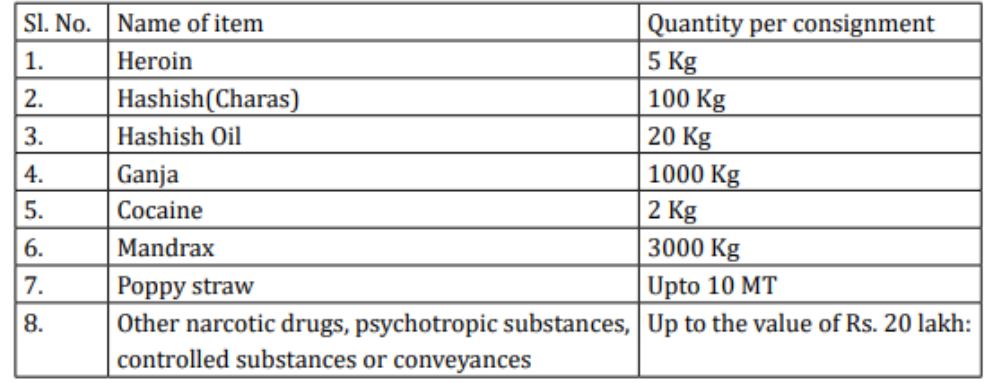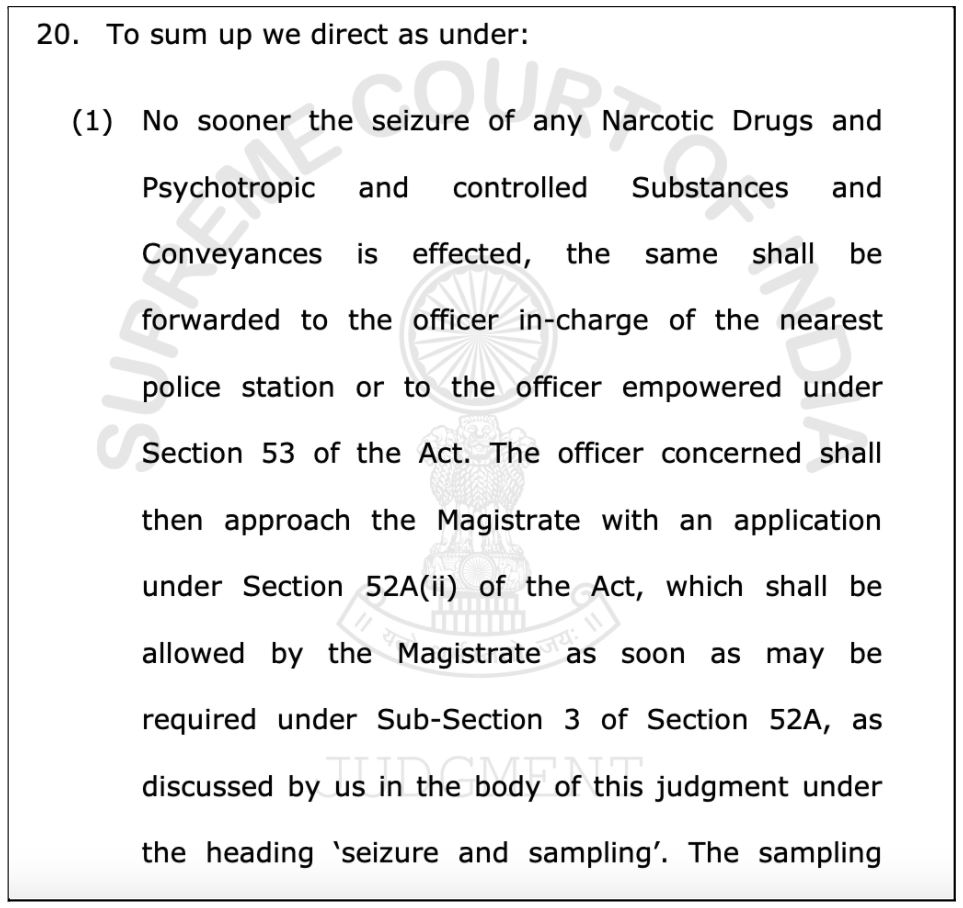Hearing a PIL, the Supreme Court noted with concern the low disposal rate of seized illicit drugs by central & state agencies, which is as low as less than 10% in some states. Even the Odisha high court recently issued directions in this regard. Here is a review of the data.
Recently, the Andhra Pradesh police set ablaze 2 lakh kilograms of seized cannabis or ganja in Vishakhapatnam district which garnered national attention. The Andhra Pradesh Police’s Twitter page shared these visuals calling it a ‘historic occasion in the annals of #APPolice’. Massive pyres were erected on the ground to burn the seized ganja as part of the state’s Operation Parivarthana launched in November 2021, aimed at curbing drug use in the state. Concerns over the intoxication effect of the burning on those who were part of the act, residents in the neighbourhood, and those witnessing it were raised.
In this context, we look at the quantum of seized drugs across various states since 2014 and the law related to the seizure of drugs.
India has ratified three international conventions on drug-related matters
Article 47 of the Constitution states that the ‘State shall endeavour to bring about prohibition of the consumption except for medicinal purposes of intoxicating drinks and of drugs which are injurious to health’. In addition, India is a signatory to three international conventions on drug-related matters viz., Single Convention on Narcotic Drugs, 1961, Convention on Psychotropic Substances, 1971 and the UN Convention Against Illicit Traffic in Narcotic Drugs and Psychotropic Substances, 1988.
In 1985, the Narcotic Drugs and Psychotropic Substances (NDPS) Act (NDPS), came into effect which prohibits, except for medical or scientific purposes, the manufacture, production, trade, use, etc. of narcotic drugs and psychotropic substances.
As per the NDPS Act, “narcotic drug” refers to coca leaf, cannabis (hemp), opium, poppy straw and includes all manufactured drugs while “psychotropic substance” refers to any substance, natural or synthetic, or any natural material or any salt or preparation of such substance or material included in the list of psychotropic substances specified in the Schedule of the legislation. The Act is applicable to the whole of India, Indian citizens outside the country, and to all persons on ships and aircrafts registered in India.
Every now and then, instances of seizure of narcotic drugs by drug law enforcement agencies such as Narcotics Control Bureau (NCB), Central Bureau of Narcotics, Directorate General of Revenue Intelligence, Commissionerates of Customs, Commissionerates of Central Excise, and Coast Guard at the national level and Police and Excise Officers at the state level are reported. The drugs of various types seized in such operations have to be disposed of from time to time, or as soon as may be, as prescribed in the NDPS Act. Section 52A of the Act provides for pre-trial disposal of drugs because of the hazardous nature, vulnerability to theft, pilferage, replacement, or constraint of proper storage space, after preparing a proper inventory of the seized items and keeping aside samples for court trials.
The procedure for disposal of seized drugs was notified in 2015
The procedure for disposal of seized drugs has been clearly enumerated in the Department of Revenue’s notification dated 16 January 2015.
When the seized drug has been forwarded to the officer-in-charge of the nearest police station or an officer of the department of central excise, narcotics, customs, or revenue intelligence, they should prepare an inventory containing the description, quality, quantity, mode of packing, marks, other identifying particulars of the drug, or the packing in which they are packed, country of origin and other such details and apply to a Magistrate within 30 days to verify the correctness of inventory prepared, take photographs and videos of the drugs, and draw representative samples as primary evidence.
Upon the Magistrate’s approval, the details are submitted to the Chairman of the Drug Disposal Committee for its decision on disposal. The 2015 order mandated that all central and state drug law enforcement agencies constitute Drug Disposal Committees with three Members each, headed by an officer not-below-the-rank of Superintendent of Police, Joint Commissioner of Customs and Central Excise, Joint Director of Directorate of Revenue Intelligence, or officers of equivalent rank.
Permission to dispose of drugs depends on the weight of contraband seized
The committee can order disposal of drugs only if the total amount of drugs in possession weighs a certain prescribed amount. If the consignments are larger in quantity or of higher value, then the Drug Disposal Committee sends its recommendations to the Head of the Department, who shall order their disposal by a High-level Drug Disposal Committee, specially constituted for this purpose.

Certain seized drugs may be sold through auction or tenders
Drugs such as Opium, morphine, codeine, and thebaine are disposed of by transferring the required quantity to the Government Opium and Alkaloid Works under the Chief Controller of Factories and the remaining is destroyed. Those Narcotic drugs, psychotropic substances, and controlled substances seized which have proper labelling may be sold through auction or tender for medical purposes under the Drugs and Cosmetics Act, 1940, if the Committee permits. The rest is destroyed.
For destroying the seized drugs, incinerators fitted with appropriate air pollution control devices, and complying with emission standards, approved by the State Pollution Control Board, where adequate facilities and security arrangements exist such that there is no health hazard or cause pollution, are to be used. Consent of the State Pollution Control Board is required. The destruction should take place in the presence of the Members of the Drug Disposal Committee. The Committee should then present a Certificate of destruction containing all the relevant information, like Godown entry number, gross and net weight of the items seized, etc. Finally, the Narcotics Control Bureau must be provided with the details of the disposed of drugs and substances in monthly reports.
Only a portion of the seized Drugs is destroyed
Drugs seized and drugs destroyed by the NCB for 2019, 2020 & 2021 is given in the below table. A gap between the contraband seized and destroyed is evident. Throughout the 3 years, over 1.51 lakh kg, 3.56 lakh bottles, 78.77 lakh tablets were seized while only 73,904 kg (about 49% of seized), 2.7 lakh bottles (76%), 21.62 lakh tablets (27.4%), were destroyed. While 22,659 ampoule of contraband was seized, 32,996 ampoules (146%) was destroyed between 2019 and 2021. Despite the seizure of 2,611 blots of contraband, nothing was destroyed.
Contraband destroyed in 2020 was lowest since 2016
The data on drug contraband (measured in kilograms) seized and disposed of by the NCB between 2014 and November 2021 indicates the following. In 2020, the net contraband destroyed was the lowest since 2016.
- Gujarat was the only state in which NCB destroyed more contraband than seized in the aforesaid period while in Chandigarh, Tamil Nadu, and Tripura, the destroyed quantity was more than 90% of the seized quantity.
- In Odisha, NCB destroyed only 6% of the seized quantity while nothing was destroyed by NCB in Kerala, Andhra Pradesh, and Telangana.
- In Himachal Pradesh, Punjab, Jharkhand, Bihar, UP, Maharashtra & Goa, Jammu & Kashmir, Assam, and Rajasthan, NCB destroyed only 20% to 40% of the contraband seized during the period.
- NCB seized the most quantity of contraband from Uttar Pradesh where over 68,114 kg was seized but only less than 25,000 kg was destroyed.
Apart from this, contraband measured in bottles, blots, tablets, plants, capsules, strips, etc. has also been seized by NCB across 19 states in the mentioned period. However, NCB has destroyed only a portion of these seized contraband in UP, Assam, Manipur, West Bengal, Bihar, Maharashtra & Goa, Gujarat, and Jammu & Kashmir.
The possibility of seized drugs re-entering the market was pointed out by the Supreme Court in 2015
It is evident from the data that the proportion of drugs destroyed is lower than that seized every year. In 2015, the Supreme Court raised doubts that the drugs being burnt in the garb of the destruction of seized drugs could be nothing but “cow dung”. It added that illicit drugs worth crores of rupees seized every year could be re-entering the market, surreptitiously sold by lower-level staff in the agencies, because of the loopholes in the system.
The Supreme Court in this case issued a slew of directions for storage & disposal to the Central & State governments.

Recently, even the Odisha High Court directed the state to dispose of all applications under the NDPS Act that seek permission for destruction of the seized contraband by all courts concerned within ten days from the date of filing. Further, it directed that all applications under NDPS Act pending before the magistrates in the different judgeships across Odisha should be disposed of on or before 01 May 2022.
Despite the court directions & a standard procedure for disposal of the seized illicit drugs, there seems to be an inordinate delay in disposal & destruction of the seized drugs, with potential for their re-entry into the market as pointed out by the SC. The need of the hour is to set timelines for disposal of applications at all levels to ensure the seized drugs are disposed of within a reasonable timeframe.
Featured Image: Disposal rate of seized illicit Drugs


